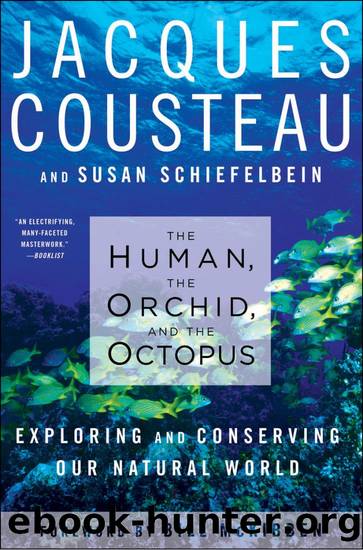The Human, the Orchid, and the Octopus by Susan Schiefelbein

Author:Susan Schiefelbein
Language: eng
Format: epub
Tags: ebook, book
ISBN: 9781596917552
Publisher: Bloomsbury Publishing
Published: 2019-12-20T00:00:00+00:00
CHAPTER EIGHT
SCIENCE AND HUMAN VALUES
I always wondered what lies under the seaânot under the surface of the sea, in the water, but under the water, under the sands of the seafloor. Sonarâs cryptic messages concealed these secrets; its taunting signal only bounced back off the bottom, simply profiling the topography of undersea terrain. My longtime friend, the electrical engineering genius Dr. Harold Edgerton of MIT, shared my intrigue with the unknown geological provinces buried below. He and I spent hours lowering cameras into the depths, but even film of the deep-sea floor didnât quell our nagging need to know what mysterious strata the bottom muds engulfed. At last Doc Edgerton devised a way to peer into these subterranean recesses: He invented instruments he called boomers and sparkers, which could hurtle powerful signals more than a mile down into the bottom. The intricate electronic echoes that reverberated back would reveal the various marbled layers of sediment that blanketed our planetâs sunken crust. I eagerly outfitted Calypso with the new equipment, hired a crew of electronic specialists, and set out to find what tiers of earth undergirded the Mediterranean basin.
As in most oceans, steep underwater canyons at the Mediterraneanâs coastline dropped precipitously to an abyssal plainâa vast expanse that usually stretches out as smooth and level as a ballroom floor. But then, halfway between Nice and Corsica, we noticed a few low, barely discernible mounds swelling up slightly from the table-flat bottom. They looked like nothing more than ordinary drifts of sand. But were they? Sheer curiosity took hold; we stopped; we crisscrossed the mounds from above, on Calypso; we bombarded them from every angle with our signals. The sparker readouts were like X-rays of planet Earth; they showed that deep within the bottom sediments lay a vast, horizontal layer of hard material, spreading out for miles in all directions. But just below us, this layer had buckled, rising in fingerlike columns that pushed upward, their tips nearly touching the surface of the seafloor, forcing up our mounds. Salt domes!
Geologists had long believed that the Mediterranean was once an inland sea; here was physical evidence. Our discovery indicated that, without its present inflow from the Atlantic, the Mediterranean had at one time actually dried away; the evaporated seawater had left behind a blanket of salt perhaps 245 feet thick, which had undulated up into our domes. We eagerly submitted the find to the French Academy of Sciences, which published our paper.
Throughout the excitement, one disconcerting fact kept rubbing uncomfortably at the back of my mind. Every oil tycoon knows that salt domes often entrap petroleum. Our domes were located in deep water, some eighty-five hundred feet down. Drilling there would be extraordinarily hazardous and accidents, inevitable. Oil spills from drilling in relatively shallow waters off Santa Barbara and in the Gulf of Mexico have been damaging enough; a spill in the deep Mediterranean would induce nothing short of disaster. The nearly enclosed waters would be renewed only very slowly; oil would irreparably
Download
This site does not store any files on its server. We only index and link to content provided by other sites. Please contact the content providers to delete copyright contents if any and email us, we'll remove relevant links or contents immediately.
Hit Refresh by Satya Nadella(8346)
When Breath Becomes Air by Paul Kalanithi(7274)
The Girl Without a Voice by Casey Watson(7272)
Do No Harm Stories of Life, Death and Brain Surgery by Henry Marsh(6343)
A Court of Wings and Ruin by Sarah J. Maas(6115)
Hunger by Roxane Gay(4236)
Shoe Dog by Phil Knight(4184)
Everything Happens for a Reason by Kate Bowler(4076)
A Higher Loyalty: Truth, Lies, and Leadership by James Comey(4041)
The Rules Do Not Apply by Ariel Levy(3914)
Tuesdays with Morrie by Mitch Albom(3842)
The Immortal Life of Henrietta Lacks by Rebecca Skloot(3833)
How to Change Your Mind by Michael Pollan(3689)
Millionaire: The Philanderer, Gambler, and Duelist Who Invented Modern Finance by Janet Gleeson(3576)
All Creatures Great and Small by James Herriot(3527)
Elon Musk by Ashlee Vance(3461)
Tokyo Vice: An American Reporter on the Police Beat in Japan by Jake Adelstein(3441)
Man and His Symbols by Carl Gustav Jung(3326)
The Money Culture by Michael Lewis(3292)
